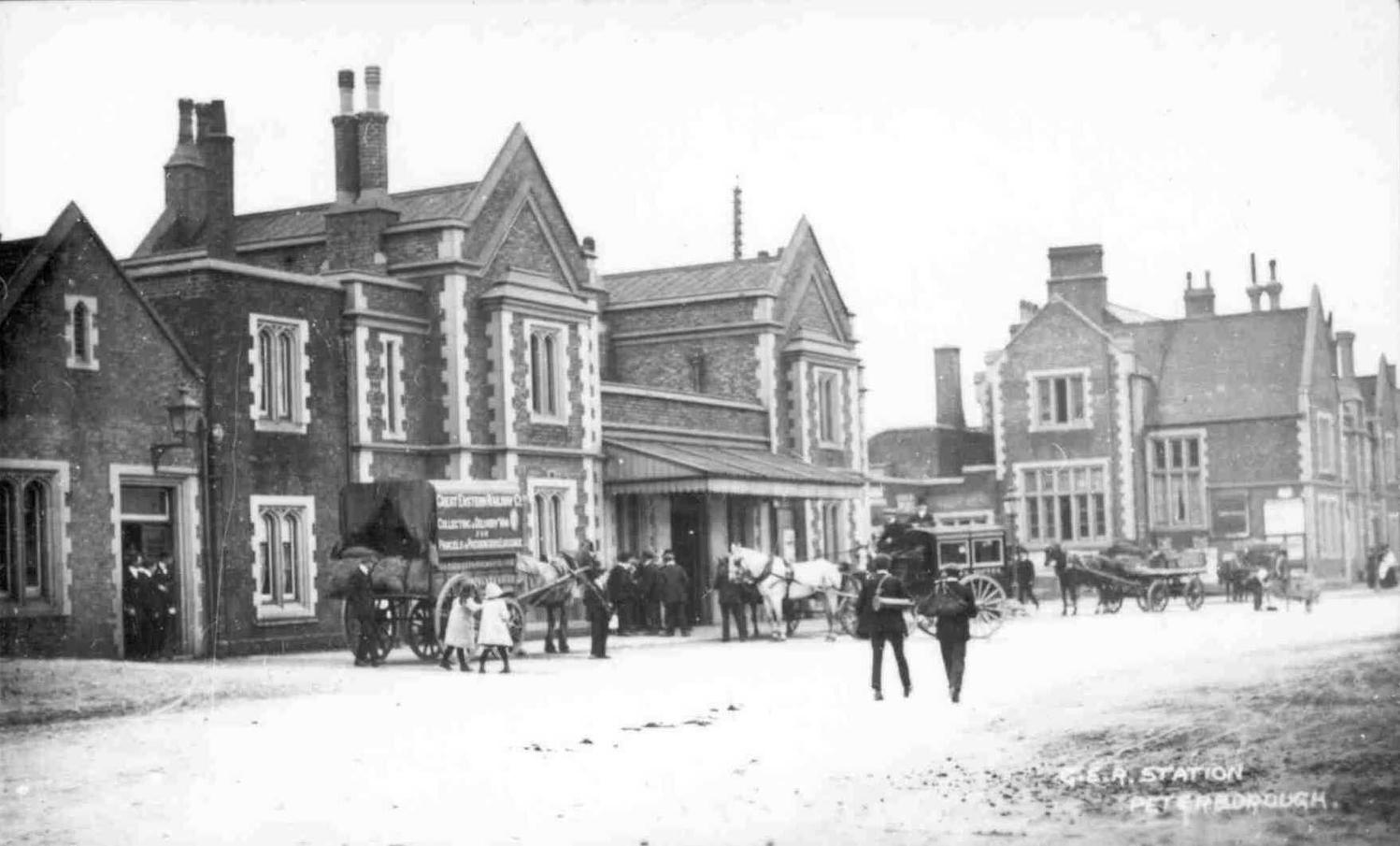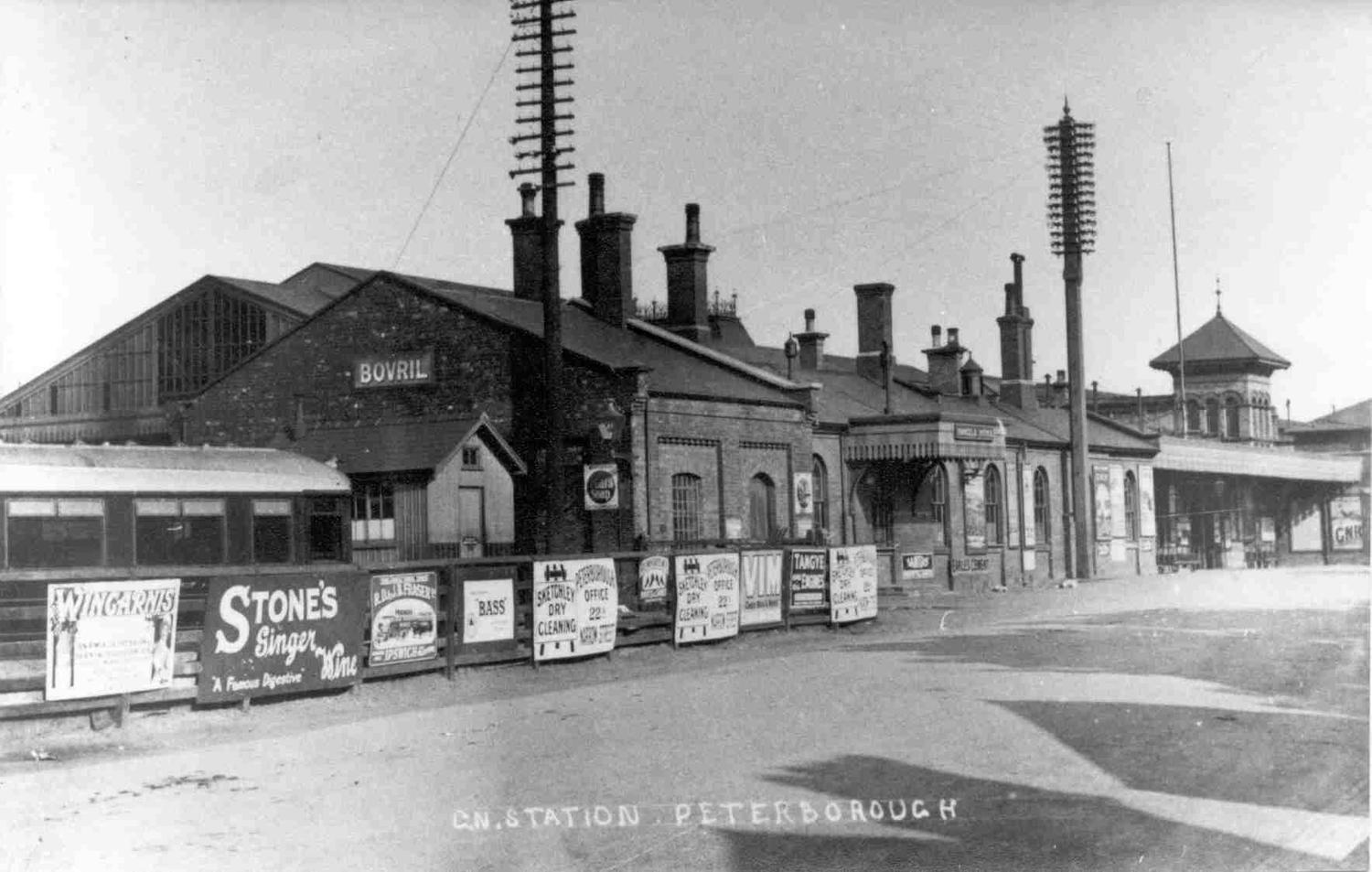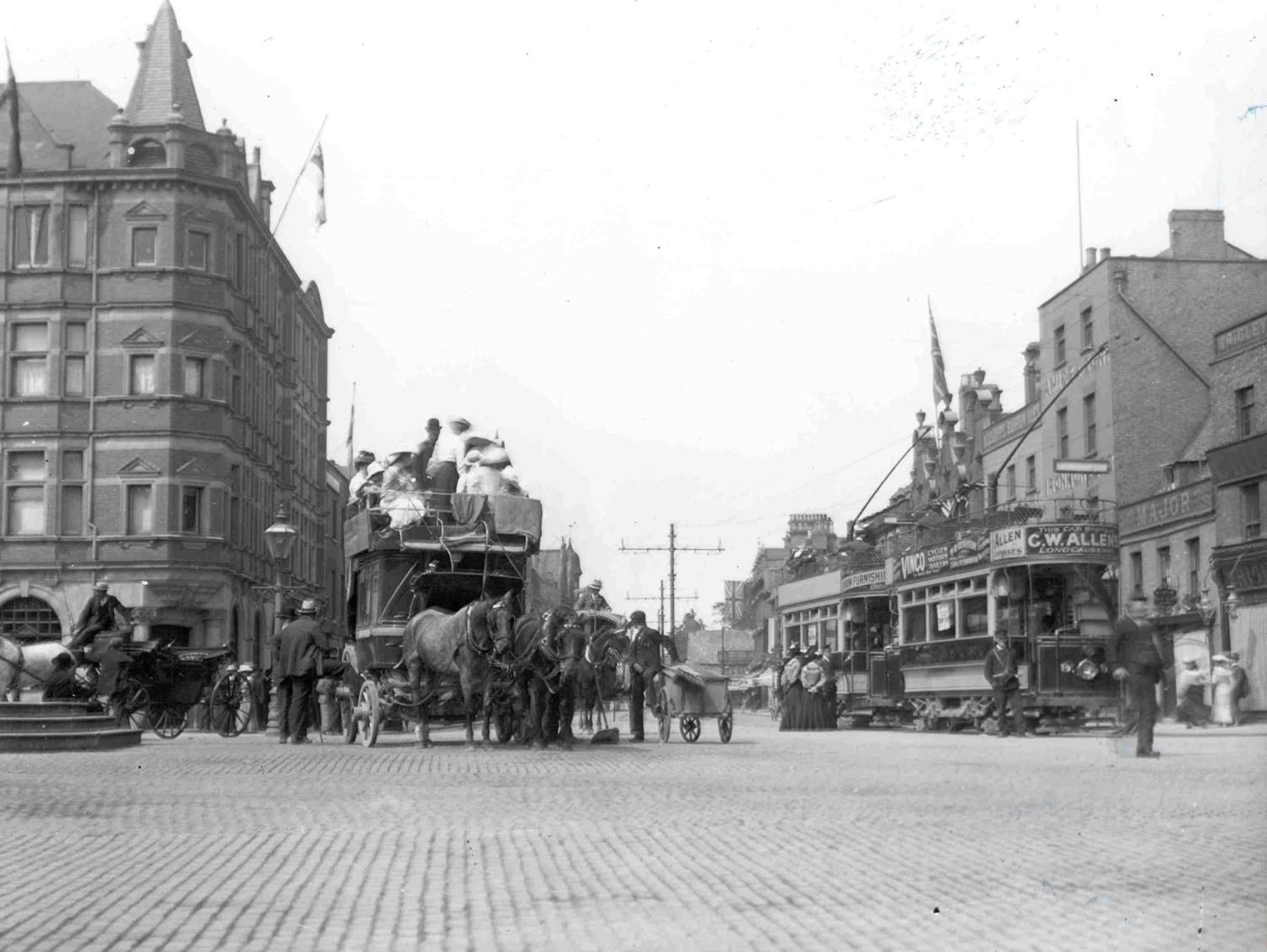Peterborough by Rail
Tuesday 10 October 2023
The development of Peterborough's Railways 1845 - 1938
The coming of the railway, Peterborough gets connected
The railways arrived in Peterborough in 1845. The first station, at Peterborough East, was on a line from Rugby to Norwich.
The lines grew fast because the land nearby was easy for engineers to lay tracks on. By 1848, there was a line to Lincoln, and in 1850, a second railway station – Peterborough North – opened on a new line from London.
Within five years Peterborough was connected to north, south, east and west. It had become the hub of a railway network. This brought rapid change, with the railways lifting Peterborough from rural obscurity. It brought jobs, skills and raw materials, and it brought distant markets within easy reach. It turned Peterborough into a place where industries such as brick-making and engineering could thrive.
The railways also brought in new people, including the Irish navvies who dug and laid the tracks. In 1861, Peterborough's population was 7,125. By 1861, the population had almost doubled, and the railways employed more than 2,000 people. By 1900, there were 35,000 people in the city, and one adult in four was a railway employee.
Peterborough is still a railway centre with an economy boosted by the income earned by London commuters.
Peterborough East Station Opens 1845
Opening on the 2nd of June 1845, Peterborough East was the first railway station in Peterborough, built by the Eastern Counties Railway (ECR). It linked Peterborough with the London and Birmingham Railway. It was located on Station Road just off the Town Bridge south of the River Nene. A section of the now defunct railway line to Northampton still survives as the Nene Valley Railway.
Although Peterborough East Station was closed to passenger traffic in June 1966, the legacy can still be seen today with the surviving railway buildings now forming part of the Fletton Quays development. The arrival of the railway heralded a new age for Peterborough, it was the catalyst for turning a small market town into the city we know today.

Cubbit's Iron Railway Bridge Built 1850
The Great Northern Railway Bridge Number 184, otherwise known as 'The Nene Viaduct', is a railway bridge immediately south of Peterborough railway station that carries trains across the River Nene. It was built in 1850 by father and son Sir William Cubitt and Joseph Cubitt for the Great Northern Railway (GNR) and was constructed using cast iron. It spans the River Nene in three arches. It's design and construction is of such note that it is a Grade II listed building, listing number: 1126894, however it should be noted that the listing incorrectly attributes Lewis Cubitt for the design.
Today the Nene Viaduct continues to provide safe passage over the river Nene for rail passengers, and is the oldest operational major cast iron bridge in the country.

Peterborough North Station Opens 1850
In 1850 the Great Northern Railway opened Peterborough North Station to service the line it was building between London and York. It was built on the site of the present mainline station.
From the 1850s to the 1960s Peterborough was a nationally important railway centre with a locomotive depot and engineering works, plus 80 miles of sidings, creating many new jobs and bringing huge growth and prosperity to the city. By 1901 the railway industry employed 25% of the city's adult male population.

Visiting the Great Exhibition 1851
The Great Exhibition, sometimes called the Crystal Palace Exhibition due to the temporary glass building constructed to hold it, was an international exhibition that took place in Hyde Park, London, from 1 May to 15 October 1851 organised by Prince Albert and Henry Cole. The magnificent building was designed by Joseph Paxton.
It was very fashionable to visit the exhibition and due to the arrival of the railway in Peterborough, the city's inhabitants had the opportunity to attend. Day trippers could leave Peterborough at 7 a.m. on the Great Northern Railway for a visit paying 5s (25p) for a second class ticket.
St Mark's Supportive Hankey 1855
St Mark's Church on Lincoln Road owes its existence to the arrival of the railways. The huge influx of railway workers and their families were provided with housing by the railway companies and churches were built for each new area. St Mark's was consecrated on 26th September 1856 and completed in 1857 thanks to a £25 donation by local M.P. Mr T. Hankey.
There was a ceremony to lay the first stone of the church in 1855. All the local dignitaries and school children gathered in Peterborough Cathedral to sing and listen to sermons before walking to the church. A total of £107 was raised by the congregation to pay for the building work.
The first foundation stone was placed in the ground with several commemorative items. These included a glass bottle with current currency and a role of parchment naming the dignitaries and architect connected to the building. Several tools were deposited which related to the Freemasons, who we may assume, were instrumental in raising money for the building and/or construction of the building.
The first vicar of St. Mark's was Rev. C. Camp/e who caused quite a commotion once by fainting during a sermon. The organ was installed in 1858 and was built by Messrs. Bryceson and Son, of London.
In 1957, to mark the centenary of the church, a new hall was added to the building.
Peterborough Provincial Benefit Building Society Founded 1860
The Peterborough Building Society was first established as the Peterborough Provincial Benefit Building Society in 1860. It was started for railway workers to support them in building their own homes at a time when Peterborough had received a huge influx of workers. Demand for housing outstripped the available housing stock, despite the railway companies building many houses themselves.
Newspapers advertised the annual meetings for members and a yearly request asking members to hand in their pass-books for auditing. Notable locations for the meetings included the Mechanic's Institute and the Bedford Coffee House.
Reference: Peterborough Standard, 6 April 1889, p. 7.
Subway Built After Tragedy 1885
Marion Ann Lloyd Dunn was knocked down and killed whilst crossing the railway on Thorpe Road on 7th January 1881. There was a huge outcry at how dangerous the crossing was and a decision was made to create a subway to pass under the railway lines instead. It was finished in 1885 and was 284ft long and 10ft wide. It was lit by several ‘Steven’s patent burner lamps’, decorated inside with white glazed bricks (the same type of tiles used in the London Underground) and the floor was paved with Wilke's patent metallic flooring laid on Eureka concrete.

The Peterborough Tramways 1903
In 1903 the Peterborough Tramways began serving the people of Peterborough with a fleet of twelve Brush electric open-topped trams, later growing to fourteen. The services were provided by the Peterborough Electric Tramway Company Ltd, a subsidiary of the British Electric Traction Company Ltd, who were founded in 1895 and went on to dominate the industry as the largest private owner of tramways throughout Britain.
The Peterborough Electric Tramway Co Ltd operated out of their Lincoln Road tram depot, dispatching trams to the 5.31 miles of electrified lines connecting Newark, Walton, and Dogsthorpe, with all lines converging at the Market Square hub on Long Causeway. Over the next twenty seven years the services were slowly phased out and replaced by more cost effective buses, the final PET Co ltd tram ran on the 30th of November 1930. In July of 1931 PET Co and the services it ran were merged with other regional services to form the Eastern Counties Omnibus Company. The old PET Co tram depot is still in use over one hundred years later, as of 2023 the depot is now operated by Stagecoach.

Railway Engine Crashes into House 1922
A family had a narrow escape when a GNER locomotive drove into their house in Peterborough. The engine was being driven by two men when they lost control of it. The men jumped out of the cab in time to see it hit a brake-van, which had been at the buffers. It then went through the buffers, off the rails, and ran into a house. It landed in the kitchen of the Cole family at around 10 am.
Earnest Cole, a railway controller, was unhurt. His wife, who was ill in bed, fell through the floor of the bedroom, but didn't suffer any serious injuries. Their 10-year-old daughter was pulled from the wreckage unharmed. His 75-year-old mother-in-law was trapped in the pantry and was suffering from severe shock when she was found. Amazingly no one was killed.
The Northampton Mercury differed in their account of the incident, claiming the daughter was 17 and elderly mother 74 and both emerged well from the incident, the daughter smiling and mother only suffering slight shock. They added that the incident 'occurred just under a bridge in the heart of the city, and... was visited by thousands during the day.'
Reference: Extraordinary Accident at Peterborough, Lichfield Mercury, Friday 18th August 1922, p. 7.
Brake Van In House, Northampton Mercury, Friday 18th August 1922, p.3.
Record-breaking Mallard Steams into Town 1938
The growth of Peterborough in the nineteenth century was thanks to the arrival of the railways. It is only fitting then, that Peterborough was part of a record-breaking railway achievement.
The East Coast Main Line that runs North to South through the city was the destination of the fastest speed achieved by a steam engine. The Mallard, an A4 class of steam locomotive, regularly travelled the route from London to Edinburgh. On July 3rd 1938 whilst heading south from Grantham towards Peterborough, it travelled faster than anyone could have hoped. It was being driven by the experienced driver Joe Duddington and Tommy Bray the fireman. Amazingly it achieved a top speed of 126mph (203kph). No other steam train has been able to achieve that speed. Tommy Bray was said to be 'grinning from ear to ear' when he arrived in Peterborough.
The London and North Eastern Railway (LNER) had planned the event and knew that pushing The Mallard to achieve such high speeds was risky. They had a back up engine waiting in Peterborough North station, which was swapped with The Mallard. The train continued its journey on to London and The Mallard turned back towards Doncaster for some TLC.
The Mallard is now part of the collection at the National Railway Museum in York.
Reference: http://www.thenorthernecho.co.uk/features/10520647.The_day_Mallard_steamed_into_the_record_books/
